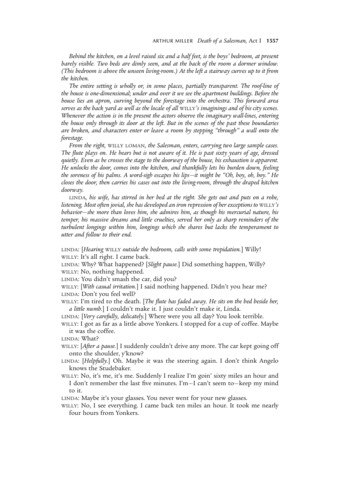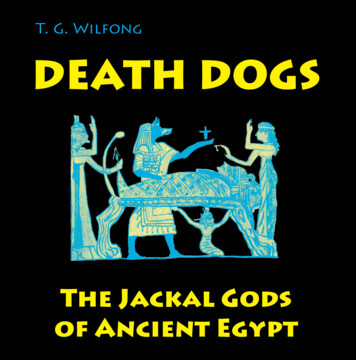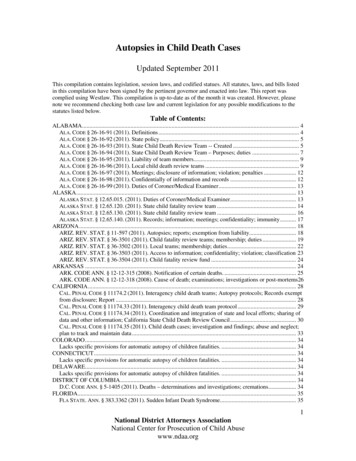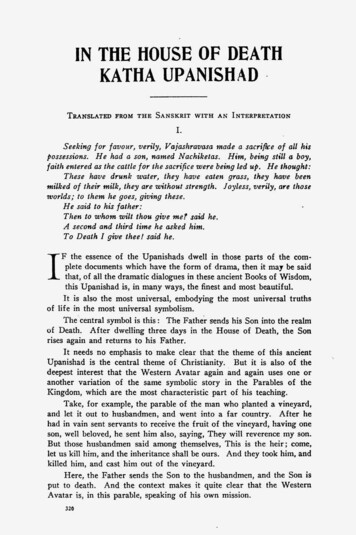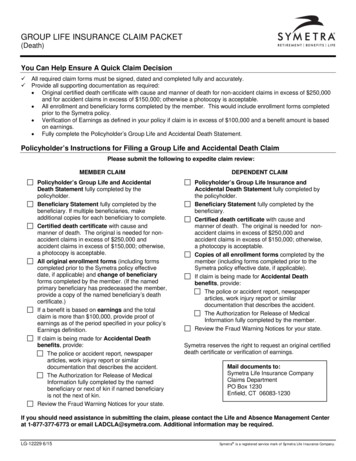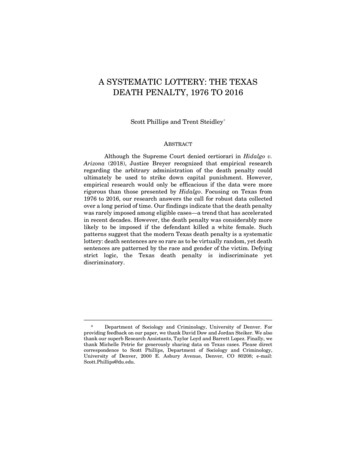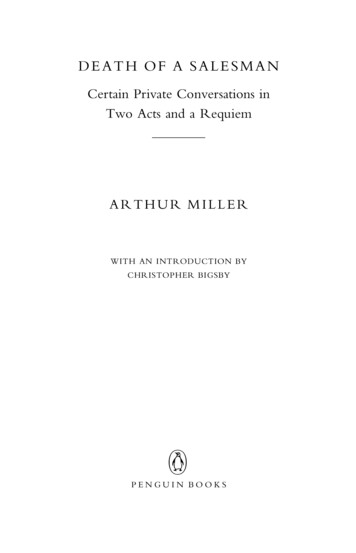
Transcription
DEATH OF A SALESMANCertain Private Conversations inTwo Acts and a RequiemARTHUR MILLERWITH AN INTRODUCTION BYCHRISTOPHER BIGSBYpPENGUIN BOOKS
penguin twentieth-century classicsDEATH OF A SALESMANArthur Miller was born in New York City in 1915 and studied at theUniversity of Michigan. His plays include All My Sons (1947), Death ofa Salesman (1949), The Crucible (1953), A View from the Bridge and AMemory of Two Mondays (1955), After the Fall (1964), Incident at Vichy(1965), The Price (1968), The Creation of the World and Other Business(1972), and The American Clock (1980). He has also written two novels,Focus (1945) and The Misfits, which was filmed in 1960, and the textfor In Russia (1969), Chinese Encounters (1979), and In the Country (1977),three books of photographs by Inge Morath. His most recent worksinclude a memoir, Mr. Peters’ Connections (1999), Echoes Down the Corridor: Collected Essays 1944–2000, and On Politics and the Art of Acting(2001). Timebends (1987), and the plays The Ride Down Mt. Morgan(1991), The Last Yankee (1993), Broken Glass (1994). He has twice wonthe New York Drama Critics Circle Award, and in 1949 he wasawarded the Pulitzer Prize.Gerald Weales is Emeritus Professor of English at the University ofPennsylvania. He is the author of Religion in Modern English Drama,American Drama Since World War II, The Play and Its Parts, TennesseeWilliams, The Jumping-Off Place, Clifford Odets, and Canned Goods as Caviar: American Film Comedy of the 1930s. Mr. Weales is the editor ofEdwardian Plays, The Complete Plays of William Wycherley, and The Viking Critical Library edition of Arthur Miller’s The Crucible. He haswritten a novel, Tale for the Bluebird, and two books for children. Mr.Weales won the George Jean Nathan Award for Drama Criticism in1965.
BY ARTHUR MILLERDRAMAThe Golden YearsThe Man Who Had All the LuckAll My SonsDeath of a SalesmanAn Enemy of the People (adaptation of the play by Ibsen)The CrucibleA View from the BridgeAfter the FallIncident at VichyThe PriceThe American ClockThe Creation of the World and Other BusinessThe Archbishop’s CeilingThe Ride Down Mt. MorganBroken GlassMr. Peters’ ConnectionsONE-ACT PLAYSA View from the Bridge, one-act version, with A Memory of Two MondaysElegy for a Lady (in Two-Way Mirror)Some Kind of Love Story (in Two-Way Mirror)I Can’t Remember Anything (in Danger: Memory!)Clara (in Danger: Memory!)The Last YankeeOTHER WORKSSituation NormalThe Misfits (a cinema novel )Focus (a novel )I Don’t Need You Anymore (short stories)In the Country (reportage with Inge Morath photographs)Chinese Encounters (reportage with Inge Morath photographs)In Russia (reportage with Inge Morath photographs)Salesman in Beijing (a memoir)Timebends (autobiography )Homely Girl, A Life (novella)COLLECTIONSArthur Miller’s Collected Plays (Volumes I and II)The Portable Arthur MillerThe Theater Essays of Arthur Miller (Robert Martin, editor)VIKING CRITICAL LIBRARY EDITIONSDeath of a Salesman (edited by Gerald Weales)The Crucible (edited by Gerald Weales)TELEVISION WORKSPlaying for TimeSCREENPLAYSThe MisfitsEverybody WinsThe Crucible
DEATH OF A SALESMANCertain Private Conversations inTwo Acts and a RequiemARTHUR MILLERWITH AN INTRODUCTION BYCHRISTOPHER BIGSBYpPENGUIN BOOKS
penguin booksPublished by the Penguin GroupPenguin Putnam Inc., 375 Hudson Street,New York, New York 10014, U.S.A.Penguin Books Ltd, 27 Wrights Lane,London W8 5TZ, EnglandPenguin Books Australia Ltd, Ringwood,Victoria, AustraliaPenguin Books Canada Ltd, 10 Alcorn Avenue,Toronto, Ontario, Canada M4V 3B2Penguin Books (N.Z.) Ltd, 182–190 Wairau Road,Auckland 10, New ZealandPenguin Books Ltd, Registered Offices:Harmondsworth, Middlesex, EnglandFirst published in the United States of America byThe Viking Press 1949Published in a Viking Compass Edition 1958Published in Penguin Books 1976This edition with an introduction by Christopher Bigsby published inPenguin Books 1998Copyright Arthur Miller, 1949Copyright renewed Arthur Miller, 1977Introduction copyright 䊚 Christopher Bigsby, 1998All rights reservedcaution: Professionals and amateurs are hereby warned that Death of a Salesmanis subject to a royalty. It is fully protected under the copyright laws of the UnitedStates of America, and of all countries covered by the International CopyrightUnion (including the Dominion of Canada and the rest of the British Commonwealth), and of all countries covered by the Pan-American Copyright Conventionand the Universal Copyright Convention, and of all countries with which theUnited States has reciprocal copyright relations. All rights, including professionaland amateur stage performing, motion picture, recitation, lecturing, public reading, radio broadcasting, television, video or sound taping, all other forms of mechanical or electronic reproduction, such as information storage and retrievalsystems and photocopying, and the rights of translation into foreign languages,are strictly reserved. Address inquiries to the author’s representative, InternationalCreative Management, 40 West 57th Street, New York, New York 10019.library of congress cataloging in publication dataMiller, Arthur, 1915 –Death of a salesman/Arthur Miller; with an introduction byChristopher Bigsby.p. cm.—(Penguin twentieth-century classics)ISBN: 1-4295-1457-41. Sales personnel—United States—Drama. 2. Fathers and sons—United States—Drama. I. Title. II. Series.PS3525.I5156D41998812'.52—dc2197–37223
CONTENTSIntroduction by Christopher BigsbyviiAct O ne1Act Tw o52Requiem110Cast113
INTRODUCTIONThe Depression of the 1930s seemed to break the promisesAmerica had made to its citizens. The stock market crash of1929, it was assumed, ended a particular version of history:optimistic, confident. The American dream faded. And yet,not so. Myths as potent as that, illusions with such a purchaseon the national psyche, are not so easily denied. In an immigrant society, which has, by definition, chosen to rejectthe past, faith in the future is not a matter of choice. Whentoday fails to offer the justification for hope, tomorrow becomes the only grail worth pursuing. Arthur Miller knewthis. When Charley, Willy Loman’s next-door neighbor,says that ‘‘a salesman is got to dream,’’ he sums up not onlyWilly’s life but a central tenet of his culture.Death of a Salesman is not set during the Depression butit bears its mark, as does Willy Loman, a sixty-three-yearold salesman, who stands baffled by his failure. Certainly inmemory he returns to that period, as if personal and nationalfate were somehow intertwined, while in spirit, accordingto Miller, he also reaches back to the more expansive andconfident, if empty, 1920s, when, according to a presidentof the United States, the business of America was business.1And since he inhabits ‘‘the greatest country in the world,’’a world of Manifest Destiny, where can the fault lie but inhimself ? If personal meaning, in this cheer leader society,lies in success, then failure must threaten identity itself. Nowonder Willy shouts out his name. He is listening for anecho. No wonder he searches desperately back through hislife for evidence of the moment he took a wrong path; nowonder he looks to the next generation to give him backvii
viiiINTRODUCTIONthat life by achieving what had slipped so unaccountablythrough his own fingers.Death of a Salesman had its origins in a short story Millerwrote at the age of seventeen (approximately the age of theyoung Biff Loman), when he worked, briefly, for his father’scompany. It told of an aging salesman who sells nothing, isabused by the buyers, and borrows his subway fare from theyoung narrator. In a note scrawled on the manuscript Millerrecords that the real salesman had thrown himself under asubway train. Years later, at the time of the play’s Broadwayopening, Miller’s mother found the story abandoned in adrawer. But, as Miller has noted, Death of a Salesman alsotraced its roots closer to home.Willy Loman was kin to Miller’s salesman uncle, MannyNewman, a man who was ‘‘a competitor, at all times, in allthings, and at every moment. My brother and I,’’ Millerexplains in his autobiography, ‘‘he saw running neck andneck with his two sons in some race that never stopped inhis mind.’’ The Newman household was one in which you‘‘dared not lose hope, and I would later think of it as a perfection of America for that reason. . . . It was a house . . .trembling with resolutions and shouts of victories that hadnot yet taken place but surely would tomorrow.’’2Manny’s son, Buddy, like Biff in Miller’s play, was a sportshero and, like Happy Loman, a success with the girls, but,failing to study, he never made it to college. Manny’s wife,meanwhile, ‘‘bore the cross of reality for them all,’’ supporting her husband, ‘‘keeping up her calm, enthusiasticsmile lest he feel he was not being appreciated.’’ (123) It isnot hard to see this woman honored in the person of LindaLoman, Willy’s loyal but sometimes bewildered wife, whois no less a victim than the husband she supports in his struggle for meaning and absolution.Though Miller spent little time with Manny, ‘‘he was so
INTRODUCTIONixabsurd, so completely isolated from the ordinary laws ofgravity, so elaborate in his fantastic inventions . . . so lyricallyin love with fame and fortune and their inevitable descenton his family, that he possessed my imagination.’’ (123) Todrop by the Newman family home, Miller explains, was ‘‘toexpect some kind of insinuation of my entire life’s probablefailure, even before I was sixteen.’’ (124) Bernard, son ofWilly’s next-door neighbor, was to find himself treated inmuch the same way by the Lomans.There is, however, something more than absurdity aboutsuch people as Manny, who managed to sustain their faithin the face of evidence to the contrary. Of a salesman friendof Manny, Miller writes, ‘‘Like any traveling man he had tomy mind a kind of intrepid valor that withstood the inevitable putdowns, the scoreless attempts to sell. In a sense,these men lived like artists, like actors whose product is firstof all themselves, forever imagining triumphs in a world thateither ignores them or denies their presence altogether. Butjust often enough to keep the game going one of themmakes it and swings to the moon on a thread of dreamsunwinding out of himself.’’ (127) And, surely, Willy Lomanhimself is just such an actor, a vaudevillian, getting by ‘‘ona smile and a shoeshine,’’ staging his life in an attempt tounderstand its plot and looking for the applause and successhe believes to be his due. He wants, beyond anything, to be‘‘well liked,’’ for, without that, he fears he will be nothingat all.During the run of his first great success, All My Sons,Miller met Manny again. Rather than comment on the play,his uncle answered a question he had not been asked:‘‘Buddy is doing very well.’’ The undeclared competitionwas still under way, as if time had stood still. The chancemeeting made Miller long to write a play that would recreate the feeling that this encounter gave him, a play that
xINTRODUCTIONwould ‘‘cut through time like a knife through a layer of cakeor a road through a mountain revealing its geologic layers,and instead of one incident in one time-frame succeedinganother, display past and present concurrently, with neitherone ever coming to a stop.’’ (131) For in that one remarkManny brought together past hopes and present realitieswhile betraying an anxiety that hinted at a countercurrentto his apparent confidence.Miller, then, likened the structure of Salesman to geological strata, in which different times are present in the sameinstant. He has also compared it to a CAT scan, which simultaneously reveals inside and outside, and the time scalein Death of a Salesman is, indeed, complex. The events onstage take place over twenty-four hours, a period which begins with a timid, dispirited, and bewildered man entering ahouse once an expression of his hopes for the future. It iswhere he and his wife raised a family, that icon of the American way, and reached for the golden glitter of the dream.He is back from a journey he once saw as a version of thoseother journeys embedded in the national consciousness, inwhich the individual went forth to improve his lot and define himself in the face of a world ready to embrace him.But the world has changed. His idyllic house, set like ahomestead against the natural world, is now hemmed in byothers, and his epic journey is no more than a drummer’sdaily grind, traveling from store to store, ingratiating himselfwith buyers or, still more, with the secretaries who guardthe buyers from him. The play ends, after a succession offurther humiliations, frustrated hopes, and demeaning memories, when Willy Loman climbs back into the car, whichitself is showing signs of debilitation, and attempts one lastride to glory, one last journey into the empyrean, finally, inhis own eyes, rivaling his successful brother, Ben, by tradinghis life directly for the dream which lured him on.
INTRODUCTIONxiBut this twenty-four-hour period is only one form oftime. There is also what Miller has called ‘‘social time’’ and‘‘psychic time.’’ By social time he seems to mean the unfolding truth of the public world which provides the contextfor Willy’s life, while psychic time is evident in memorieswhich crash into his present, creating ironies, sounding echoes, taunting him with a past which can offer him nothingbut reproach. All these different notions of time blend andinteract, that interaction being a key to the play’s effect. But,of course, all these differing time schemes are themselvescontained within and defined by the audience’s experienceof the play, a shared moment in which the social reality ofthe occasion (its performance, say, in Communist China inthe 1980s) and the psychological reality of individual audience members themselves affect the meaning generated bythe stage action.The past, and its relationship to the present, has alwaysbeen vital to Mille
meeting made Miller long to write a play that would re-create the feeling that this encounter gave him, a play that. x INTRODUCTION would ‘‘cut through time like a knife through a layer of cake or a road through a mountain revealing its geologic layers, and instead of one incident in one time-frame succeeding another, display past and present concurrently, with neither one ever coming to a .
